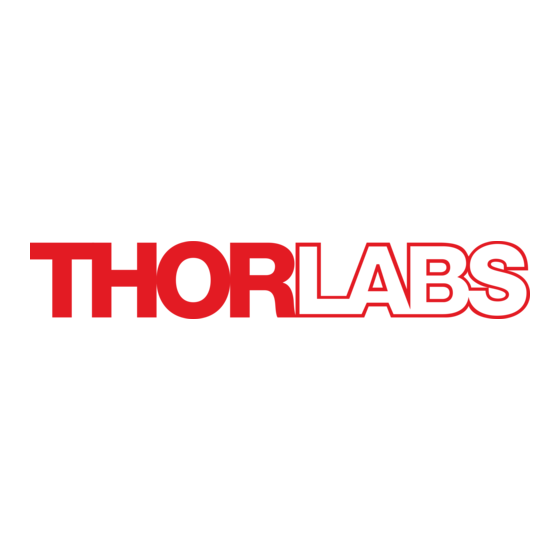
Table of Contents
Advertisement
Quick Links
Advertisement
Table of Contents

Summary of Contents for THORLABS FDPS3X3
- Page 1 FDPS3X3 Lead Sulfide Photoconductor User Guide...
-
Page 2: Table Of Contents
Chapter 5 Mechanical Drawing ............12 Chapter 6 Regulatory ................ 13 6.1. Waste Treatment is Your Own Responsibility .... 13 6.2. Ecological Background ..........13 Chapter 7 Thorlabs Worldwide Contacts ........14 Page 1 Rev B, September 8 , 2014... -
Page 3: Chapter 1 Warning Symbol Definitions
Chapter 1: Warning Symbol Definitions Chapter 1 Warning Symbol Definitions Below is a list of warning symbols you may encounter in this manual or on your device. Symbol Description Direct Current Alternating Current Both Direct and Alternating Current Earth Ground Terminal Protective Conductor Terminal Frame or chassis Terminal Equipotentiality... -
Page 4: Chapter 2 Description
PbS Detector Chapter 2 Description The Thorlabs FDPS3X3 photoconductor is a Lead Sulfide Detector (PbS), which is ideal for measuring both pulse and chopped infrared light sources. The photoconductor is housed conveniently in a TO-5 package which offers easy integration into existing setup and/or systems. The Lead Sulfide detector is modeled as a resistor: as the detector area is illuminated with IR radiation the effective resistance of the photoconductor is reduced. -
Page 5: Frequency Response
3.2. Frequency Response Photoconductors must be used with a pulsed signal, to obtain AC signals. An optical chopper, such as the Thorlabs MC2000, is recommended for use with CW light. The detector responsivity (R ) when using a chopper can be calculated... -
Page 6: Temperature Considerations
PbS Detector The characteristic curve for Signal vs. Chopping Frequency for this particular detector is provided in chapter 4. 3.4. Temperature Considerations These detectors consist of a thin film on a glass substrate. The effective shape and active area of the photoconductive surface varies considerably based upon the operating conditions, thus changing performance characteristics. -
Page 7: Dark Resistance
Chapter 3: Operation 3.7. Dark Resistance Dark Resistance is the resistance of the detector under no illumination. It is important to note the dark resistance will increase or decrease with temperature. Cooling the device will increase the dark resistance. Provided in chapter 4, is a Dark Resistance vs. - Page 8 PbS Detector increase. Provided in chapter 4 is a SNR vs. Supply Voltage characteristic curve to help determine best operating condition. The output voltage is derived as the following: = F1 + H ∗ 9 Feedback Resistor LOAD C filter R filter Detector Optical...
-
Page 9: Chapter 4 Specifications
Chapter 4: Specifications Chapter 4 Specifications All measurements performed with a 50 Ω load unless stated otherwise. Electrical Specifications Detector 3.0 x 3.0 mm (9 mm Active Area Wavelength Range 1000 to 2900 nm λ 2200 nm (Typ.) Peak Wavelength λ... -
Page 10: Response Curve
PbS Detector 4.1. Response Curve PbS Photoconductor Responsivity 50,000 40,000 30,000 20,000 10,000 1.25 1.75 2.25 2.75 Wavelength ( μm 4.2. SNR vs. Chopping Frequency SNR vs. Chopping Frequency Supply Voltage: 15 V, Rise Time: 200 μs Signal Noise 1000 Chopping Frequency Page 9 Rev B, September 8... -
Page 11: Snr Vs. Supply Voltage
Chapter 4: Specifications 4.3. SNR vs. Supply Voltage SNR vs. Supply Voltage Chopping Frequency: 600Hz, Bandwidth: 60Hz Signal Noise Supply Voltage (V) 4.4. Dark Resistance vs. Temperature Dark Resistance vs. Temperature Temperature (°C) 24700-D02 Page 10... -
Page 12: Temperature Vs. Sensitivity
PbS Detector 4.5. Temperature vs. Sensitivity Temperature vs. Sensitivity Chopping Frequency: 600Hz, Supply Voltage: 15V Temperature (°C) Page 11 Rev B, September 8 , 2014... -
Page 13: Chapter 5 Mechanical Drawing
Chapter 5: Mechanical Drawing Chapter 5 Mechanical Drawing Visit the web for a more detailed mechanical drawing. 24700-D02 Page 12... -
Page 14: Chapter 6 Regulatory
6.1. Waste Treatment is Your Own Responsibility If you do not return an “end of life” unit to Thorlabs, you must hand it to a company specialized in waste recovery. Do not dispose of the unit in a litter bin or at a public waste disposal site. -
Page 15: Chapter 7 Thorlabs Worldwide Contacts
Chapter 7 Thorlabs Worldwide Contacts For technical support or sales inquiries, please visit us at www.thorlabs.com/contact for our most up-to-date contact information. USA, Canada, and South America UK and Ireland Thorlabs, Inc. Thorlabs Ltd. sales@thorlabs.com sales.uk@thorlabs.com techsupport@thorlabs.com techsupport.uk@thorlabs.com Europe Scandinavia... - Page 16 www.thorlabs.com...
Need help?
Do you have a question about the FDPS3X3 and is the answer not in the manual?
Questions and answers